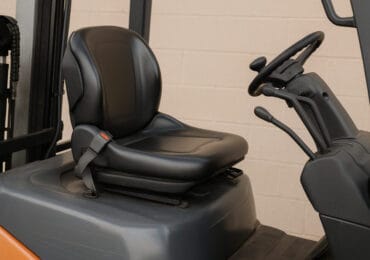
In the fast-paced world of material handling, forklift operators spend countless hours maneuvering heavy loads through warehouses, distribution centers, and industrial facilities. While much attention is given to engine performance, lifting capacity, and safety features, one crucial component often gets overlooked: the operator’s seat. Quality forklift seats are far more than just a place to sit – they’re essential safety equipment that directly impacts productivity, operator health, and overall operational efficiency.
Enhanced Operator Comfort and Reduced Fatigue
The most immediate benefit of investing in quality forklift seats is the dramatic improvement in operator comfort. Professional-grade seats feature ergonomic designs that support the natural curvature of the spine, reducing pressure points and minimizing discomfort during extended shifts.
High-quality seats incorporate advanced cushioning materials that maintain their shape and support properties over time. Memory foam, gel inserts, and multi-density padding work together to distribute weight evenly, preventing the soreness and stiffness associated with inferior seating solutions. This enhanced comfort translates directly into reduced operator fatigue, allowing workers to maintain peak performance throughout their shifts.
Adjustability is another crucial comfort factor. Premium forklift seats offer multiple adjustment options including height, tilt, lumbar support, and armrest positioning. This customization ensures that operators of different sizes and preferences can find their optimal seating position, further enhancing comfort and reducing physical strain.
Significant Safety Improvements
Safety should always be the top priority in any industrial environment, and quality forklift seats play a vital role in maintaining safe operations. Properly designed seats help operators maintain better control of their equipment by providing stable, secure positioning that doesn’t shift or slide during operation.
Many high-end forklift seats include integrated safety features such as seat belt systems, weight-activated switches, and presence sensors. These features ensure that operators remain properly secured and that the forklift cannot operate unless someone is correctly positioned in the driver’s seat.
The improved visibility that comes with proper seating position cannot be overstated. When operators are comfortable and properly positioned, they can maintain better awareness of their surroundings, spot potential hazards more quickly, and react appropriately to changing conditions. This enhanced situational awareness significantly reduces the risk of accidents and injuries.
Boosted Productivity and Performance
Comfortable operators are productive operators. When drivers aren’t constantly shifting to find a comfortable position or dealing with back pain and discomfort, they can focus entirely on their tasks. This concentration leads to faster cycle times, more accurate load placement, and overall improved operational efficiency.
Quality seats also reduce the need for frequent breaks. Operators experiencing discomfort often need to stop and stretch or adjust their position, leading to downtime that impacts productivity. With proper seating, operators can work longer periods without discomfort, maintaining consistent performance levels throughout their shifts.
The psychological benefits shouldn’t be ignored either. Operators who feel that their employer has invested in their comfort and wellbeing typically demonstrate higher job satisfaction, better attendance, and increased loyalty to the company.
Long-term Health Benefits
Poor seating can lead to serious long-term health issues including chronic back pain, neck strain, and repetitive stress injuries. These conditions not only affect the individual operator’s quality of life but also result in increased healthcare costs, workers’ compensation claims, and potential liability for employers.
Quality forklift seats are designed with proper lumbar support to maintain the spine’s natural S-curve, reducing stress on vertebrae and surrounding muscles. Shock absorption features help minimize the impact of vibrations and sudden movements that can contribute to spinal compression and joint problems over time.
By investing in ergonomic seating solutions, companies demonstrate their commitment to employee health and can significantly reduce the incidence of work-related musculoskeletal disorders.
Cost-Effectiveness and Return on Investment
While quality forklift seats represent a higher upfront investment compared to basic alternatives, they deliver exceptional value over time. Premium seats are built with durable materials and superior construction methods that ensure longevity, reducing replacement frequency and associated downtime.
The reduction in operator sick days, workers’ compensation claims, and turnover rates can result in substantial cost savings. Additionally, the productivity gains from having alert, comfortable operators often more than justify the initial investment within the first year.
Improved Equipment Longevity
Quality seats don’t just benefit operators – they also help protect the forklift itself. Cheap seats that wear out quickly can create debris, damage surrounding components, or cause operators to make sudden movements that stress the equipment. High-quality seats maintain their integrity over time, contributing to the overall longevity of the forklift.
Making the Right Choice
When selecting forklift seats, consider factors such as adjustability options, cushioning quality, durability of materials, and compatibility with existing safety systems. Look for seats that meet industry standards and come with comprehensive warranties.
The investment in quality forklift seats pays dividends through improved operator satisfaction, enhanced safety, increased productivity, and reduced long-term costs. In today’s competitive business environment, companies that prioritize operator comfort and wellbeing gain a significant advantage in attracting and retaining skilled workers while maintaining peak operational efficiency.